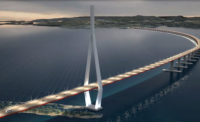Murphy also notes that India has its own strong stable of designers to compete against. “Success in India depends on whether the client sees us bringing added value. It is impossible to compete with local companies unless the client believes we are bringing this value,” he says.
The Middle East continues to offer “the same old mix of opportunities and risks,” says Howells. Mott is cool about Saudi Arabia, which the firm perceives as risky due to regional tensions and low oil prices. In the Middle East, “we go in with first-rate contractors,” adds Søbye. He sees opportunities in Qatar and also in Saudi Arabia.
Some firms remain optimistic about the Middle East. Despite falling oil prices, the Gulf region, particularly in the United Arab Emirates and Saudi Arabia, is showing a diversification of markets, says McIntyre of IBI Group. “But with it, there is significant competition in the areas of consulting, including industrial development, transportation, infrastructure, mixed use, resorts and residential,” he says.
Keeping It Local
For international designers, local competition and local workers and material-use policies are becoming a bigger concern. “Localization constraints also have become stronger,” says Aubarbier of Assystem. “We believe that international expertise must be coupled with the capacity to deliver locally.”
Policies that favor local companies are arising in some of the most promising markets. In Indonesia, “the shift of policy emphasis toward domestic aspects seems to be negatively affecting the participation of international design firms,” says Motomura of PADECO Co.
Financing patterns also have been evolving, particularly in developing countries. “Although [Japan’s] Official Development Assistance [ODA] projects have, until now, been an important part of our work, some developing countries, which used to be significant recipients of Japanese ODA, have seen their economies grow rapidly,” says Mori of Chodai.
Thus, these developing countries are less interested in financing projects with ODA than before and are increasingly looking to other means of funding, such as public-private partnerships and private financing initiatives, Mori says. “Such developing countries have also developed their technological capabilities and can nowadays design and construct many projects that, in the past, would have required foreign assistance.”
The answer for many international designers is simply being local in a global market. For example, Dohwa Engineering has been opening local offices and hiring local experienced experts. “Local offices have been working to keep good relations with the local contractors, while the head office provides training and production of proposal documents,” says Park.








